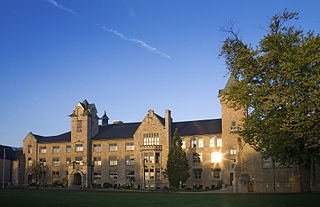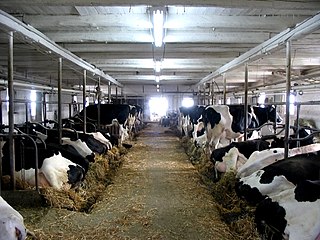
Guelph is a city in Southwestern Ontario, Canada. Known as The Royal City, it is roughly 22 km (14 mi) east of Kitchener and 70 km (43 mi) west of Downtown Toronto, at the intersection of Highway 6, Highway 7 and Wellington County Road 124. It is the seat of Wellington County, but is politically independent of it.

Cambridge is a city in the Regional Municipality of Waterloo, Ontario, Canada, located at the confluence of the Grand and Speed rivers. The city had a population of 138,479 as of the 2021 census. Along with Kitchener and Waterloo, Cambridge is one of the three core cities of Canada's tenth-largest metropolitan area.

The Regional Municipality of Waterloo is a metropolitan area of Southern Ontario, Canada. It contains the cities of Cambridge, Kitchener and Waterloo, and the townships of North Dumfries, Wellesley, Wilmot and Woolwich. Kitchener, the largest city, is the seat of government.

The Canada Company was a private British land development company that was established to aid in the colonization of a large part of Upper Canada. It was incorporated by royal charter on August 19, 1826, under the Canada Company Act 1825 of the British parliament, which was given royal assent on June 27, 1825. It was originally formed to acquire and develop Upper Canada's undeveloped clergy reserves and Crown reserves, which the company bought in 1827 for £341,000 ($693,000) from the Province of Upper Canada.

Puslinch is a township in south-central Ontario, Canada, in Wellington County, surrounding the south end of Guelph. The main source of production is agricultural, spring water bottling and mining. Aggregate mining has been dominant throughout the county. About half of the township is forested, and a conservation area lies to the southwest. Near the western edge of the township, just outside Cambridge, Ontario, is Puslinch Lake, the largest kettle lake in North America. It is part of the Guelph census metropolitan area.

Breed broiler is any chicken that is bred and raised specifically for meat production. Most commercial broilers reach slaughter weight between four and six weeks of age, although slower growing breeds reach slaughter weight at approximately 14 weeks of age. Typical broilers have white feathers and yellowish skin. Broiler or sometimes broiler-fryer is also used sometimes to refer specifically to younger chickens under 2.0 kilograms, as compared with the larger roasters.

The Dorking is a British breed of domestic chicken. It is named after the town of Dorking, in Surrey in southern England.
Galt is a community in Cambridge, Ontario, Canada, in the Regional Municipality of Waterloo, Ontario on the Grand River. Prior to 1973, it was an independent city, incorporated in 1915, but amalgamation with the village of Hespeler, the town of Preston and the village of Blair formed the new municipality of Cambridge. Being the largest constituent community in the city, it is commonly seen as the downtown core of Cambridge. The first mayor of Cambridge was Claudette Millar.

Colonel Robert Samuel McLaughlin, was a Canadian businessman and philanthropist. He started the McLaughlin Motor Car Company in 1907, one of the first major automobile manufacturers in Canada, which evolved into General Motors of Canada.

The Indian Game is a British breed of game chicken, now reared either for meat or show. It originated in the early nineteenth century in the counties of Cornwall and Devon in south-west England. It is a heavy, muscular bird with an unusually broad breast; the eggs are brown.

Canada is one of the largest agricultural producers and exporters in the world. As with other developed nations, the proportion of the population agriculture employed and agricultural GDP as a percentage of the national GDP fell dramatically over the 20th century, but it remains an important element of the Canadian economy. A wide range of agriculture is practised in Canada from Newfoundland on the Atlantic to British Columbia on the Pacific. In the federal government, overview of Canadian agriculture is the responsibility of the Department of Agriculture and Agri-Food.

Yukon Gold is a large cultivar of potato most distinctly characterized by its thin, smooth, eye-free skin and yellow-tinged flesh. This potato was developed in the 1960s by Garnet ("Gary") Johnston in Guelph, Ontario, Canada, with the help of Geoff Rowberry at the University of Guelph. The official cross bred strain was made in 1966 and 'Yukon Gold' was finally released into the market in 1980.

Galt Collegiate Institute and Vocational School (GCI) is one of sixteen secondary schools in the Waterloo Region District School Board, located in Cambridge, Waterloo, and Kitchener, Ontario, Canada.

The Legbar is a rare British auto-sexing breed of chicken. It was created in the early twentieth century by Reginald Crundall Punnett and Michael Pease at the Genetical Institute of Cambridge University. They cross-bred American barred Plymouth Rock birds with brown Leghorns and created the gold and silver colour varieties. Pease created a cream Legbar by cross-breeding these with white Leghorns; later crossing with Araucanas caused this to have a crest and to lay blue or blue-green eggs.

The Sebright is a British breed of bantam chicken. It is a true bantam – a miniature bird with no corresponding large version – and is one of the oldest recorded British bantam breeds. It is named after Sir John Saunders Sebright, who created it as an ornamental breed by selective breeding in the early nineteenth century.

The Buckeye is an American breed of chicken. It was created in Ohio in the late nineteenth century by Nettie Metcalf. The color of its plumage was intended to resemble the color of the seeds of Aesculus glabra, the Ohio Buckeye plant for which the state is called the 'Buckeye State'.

Canada's supply management, abbreviated SM, is a national agricultural policy framework used across the country, which controls the supply of dairy, poultry and eggs through production and import controls and pricing mechanisms. The supply management system was authorized by the 1972 Farm Products Agencies Act, which established the two national agencies that oversee the system. The Agriculture and Agri-Food Canada federal department is responsible for both the Canadian Dairy Commission and its analogue for eggs, chicken and turkey products, the Farm Products Council of Canada. Five national supply management organizations, the SM-5 Organizations — Egg Farmers of Canada (EFC), Turkey Farmers of Canada (TFC), Chicken Farmers of Canada (CFC), the Canadian Hatching Egg Producers (CHEP) and the Ottawa-based Canadian Dairy Commission (CDC), a Crown corporation — in collaboration with provincial and national governing agencies, organizations and committees, administer the supply management system.

The broiler industry is the process by which broiler chickens are reared and prepared for meat consumption. Worldwide, in 2005 production was 71,851,000 tonnes. From 1985 to 2005, the broiler industry grew by 158%.
Ron Smith was a Canadian professional ice hockey coach in the American Hockey League (AHL) and the National Hockey League (NHL). Smith held various coaching roles including head coach of the Binghamton Rangers of the AHL from 1991 to 1993 and was the interim head coach for the New York Rangers of the NHL in 1993. Smith was inducted into the Cambridge Sports Hall of Fame in 2002.
Robert Black is a Canadian Senator from Ontario. He was named to the Senate by Prime Minister Justin Trudeau on February 15, 2018. Prior to his appointment, Black was a leader in the agricultural community. He has been chief executive of the Rural Ontario Institute since 2010 and has also been involved in the 4-H farm youth organization since the 1970s. He subsequently joined the Independent Senators Group and, on November 4, 2019, he joined the Canadian Senators Group.

















